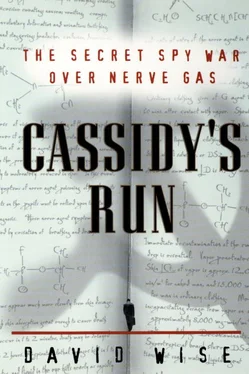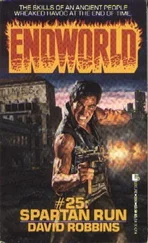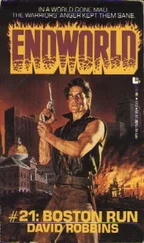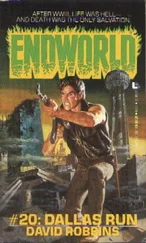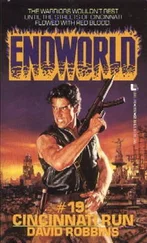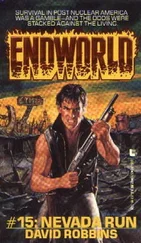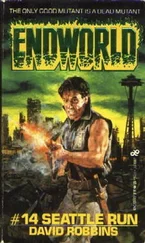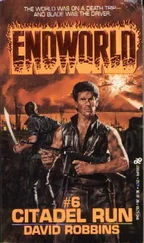More important, in 1972 Soviet intelligence learned the actual formula for VX, which had been invented in Britain and shared only with the scientists at Edgewood. Full-scale Soviet production of VX started in 1972 at Novocheboksarsk.
A dozen years earlier, Soviet scientists had read in the openly available literature that the United States was gearing up to produce soman. But the information was incorrect, although production had been under consideration.
At Edgewood in the late 1950s Benjamin Harris had in fact urged his bosses to commit to large-scale production of soman. Harris, a chemical engineer, had served in the Army Chemical Corps during World War II. He had been an assistant professor at Johns Hopkins University when he began consulting at Edgewood on how to handle the sarin that had been captured from the Nazis. “I went around to storage sites and advised people on handling the GB. How to open containers safely.” In 1949, Harris left academe for full-time work at Edgewood.
At that time, the scientists at Edgewood and army officials were still debating which of the major nerve gases to choose for large-scale production. Harris did a study of soman (GD): “I came to the conclusion that [its] increased toxicity and other properties made it a more efficient chemical agent.”
There was, however, a problem. Unlike sarin, which is produced with ordinary alcohol, soman relies on pinacolyl alcohol, a much more exotic substance. [3] Pinacolyl alcohol combined with methyl phosphonofluoridate creates soman, or pinacolyl methyl phosphonofluoridate. The second chemical component of soman is identical to that used in sarin; only the alcohol is different.
“It was a lot more expensive to manufacture, because it is a much more complicated alcohol, for which a plant would have to be built. There was no large-scale plant available in the U.S. at that time.”
But in Harris’s view, the cost of producing the pinacolyl alcohol was outweighed by the advantages. “If one makes a cost-benefits analysis of the cost of delivery of a weapon to the target, the cost of the fill is an insignificant portion of the total. The cost of delivery is much higher.
“Everybody knew soman was more toxic, and it is also more persistent, because the heavier alcohol makes the gas more persistent. Among the gases, GD, soman, is in the middle; it lasts longer than GB, but it’s not as persistent as VX. You can make it more persistent by putting in a thickener. I urged them to make GD,” Harris said. “I made that recommendation to Sy Silver,” Edgewood’s technical director at the time.
“We didn’t do it. They decided to make GB. It was decided at a high level.”
Saul Hormats recalled the decision. “Soman was not used,” he said, “because I decided GB was better, more volatile, you get a fast cloud with it. You would have to make a new alcohol for soman, and GB used normal alcohol, already available. You can’t buy a big tank-car load of pinacolyl alcohol, but you can buy one of rubbing alcohol.”
But none of this was known at the Kirov Chemical Works in Volgograd.
Large-scale production of sarin (GB) had begun at Volgograd in 1959 but the Russian scientists considered soman the best nerve gas they had at the time. They had first learned of it when the Soviet army captured the Spandau lab, west of Berlin, at the end of the war.
“At first, the Russian military establishment was against GD,” said a former Soviet scientist who preferred not to be identified. “They were interested in VX. Then they changed their minds. If America had large-scale GD, we must have it.”
And so, by 1960, the Russians had committed to large-scale production of soman, in the mistaken belief that the United States was following the same course. But they faced the identical problem of how to extract pinacolyl alcohol. Although relatively simple to produce today—it is used in the manufacture of a number of herbicides and fungicides—at the time, pinacolyl alcohol required five stages of electrolysis to produce. Work began on construction of a separate unit of the vast Volgograd complex to perform the electrolysis and begin full-scale production of soman.
With the Lenin Prize and increasing responsibility for the Soviet nerve-gas program, Boris Libman’s star was on the rise. Then, early in February 1965, a frightening event took place that was, for Libman, a harbinger of personal disaster. A levee on the Volga was destroyed by melting snow. At the plant, there was near panic because Libman and the other scientists feared that they might have contaminated a tidal pool behind the levee. If so, there was a real danger that tens of thousands of people in the lower regions of the Volga might be poisoned.
Hurriedly, the scientists began testing the river as far as twelve miles downstream. To their immense relief, they found no traces of nerve gas. After a day and a half, the levee was repaired, and the danger passed.
For Libman, however, the reprieve was short-lived. Four months later, on June 15, he looked out at the river and was horrified at what he saw. The Volga had turned white.
That, as closer inspection revealed, was the visual effect of thousands of fish that had died and turned belly-up. The immense fish kill extended for fifty miles along the river. The nerve-gas plant was immediately suspected as the logical cause.
Libman, however, soon discovered what he believed to be the real source of the ecological disaster: The huge Volgograd hydroelectric power station had closed its gates, and the river was twelve feet lower than normal. As a result, the heat of the sun had made the water warmer. All the dead fish were sturgeon, which are more sensitive to high temperature than other fish.
Libman’s protests were to no avail. As the chief engineer at the plant, a nonethnic Russian, and a Jew, he was an obvious target. Nor was it easy for Libman to prove that pollution from the nerve-gas plant had not somehow contributed to the fish kill. Libman might also have been blamed because Moscow had begun a large-scale program of hydropower construction up and down the Volga; to admit that the power station had caused the fish kill might have brought that project to a halt.
On March 9, 1966, Boris Libman was convicted of negligence and sentenced to two years in a prison labor camp in nearby Volsky. At the time, he was forty-three years old. He was stripped of his military medals and fined ten thousand new rubles, which was ten times the value of his Lenin Prize and the equivalent of two years’ salary. Six other officials of the chemical plant were convicted and fined but not sent to prison.
In an interview with the author in Moscow in 1993, Vil Mirzayanov, a scientist who worked for years in the Soviet nerve-gas program, blamed the fish kill on the chemical plant. “Boris Libman was chief engineer of the Volgograd plant in charge of soman production. Some of the soman toxins polluted the Volga, and the fish went belly-up. [Aleksei] Kosygin, then the prime minister, ordered someone be made an example, and Libman became the scapegoat.” [4] Mirzayanov’s theory about why the fish died might be correct, but full-scale production of soman had not yet begun in 1965, the year the fish kill occurred. The electrolysis plant that was needed to produce the necessary pinacolyl alcohol was still under construction at the time, and major production of soman at Volgograd did not begin until 1968.
In the prison camp, Libman worked first as a foreman of a construction crew, building houses. After some months, he was allowed to work in a chemical plant during the day, developing phospho-organic stabilizers for rubber. To do so, he left the prison during the day but had to be back inside by 10 P.M. Any later than that would be considered an escape, and five more years would be added to his sentence.
Читать дальше
